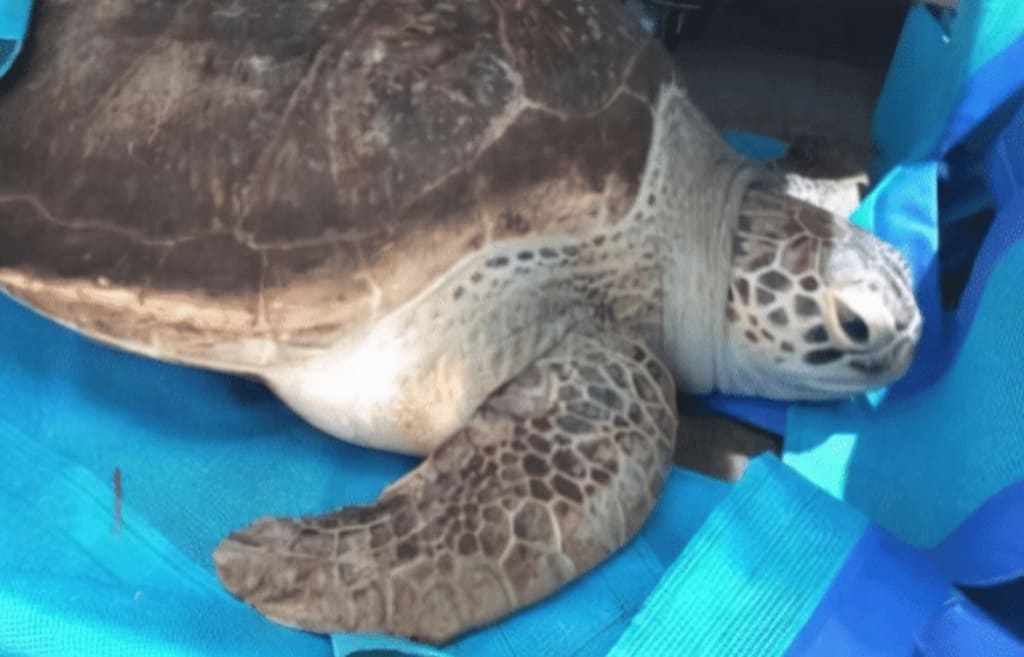
A giant sea turtle died after swallowing 6 pounds of marine garbage
Recently, a sea turtle weighing more than 200 pounds in Sanya was rescued because of an abnormal reaction. However, shortly after being brought back to the rescue center, the turtle unfortunately died. The veterinarian wanted to determine the cause of the disease through autopsy but found a large number of foreign objects in the turtle's body, such as masks, plastic bags, fishing nets, and other marine garbage. The garbage clogged the turtle's intestines and consequently left them necrotic.
How hard it must be for the turtles to swallow this marine garbage! The damage and impact of marine garbage on the ocean are great, and here we will prove it with some facts.
Marine Litter
Marine litter is the most pervasive threat to the world's coastal areas and the ecological health of the oceans. It is an issue that is being closely watched globally (except by one of our neighbors). Marine litter can seriously harm marine and coastal animals; interfere with the safety of human navigation; cause economic losses to fisheries and shipping, and ultimately threaten the health and safety of humans themselves.

Marine litter is defined as "any persistent solid material that is directly or indirectly, intentionally or unintentionally, disposed of or discarded into the marine environment". All man-made items that are not supposed to enter the ocean are considered marine litter. Marine litter can be found even in the deepest Marianas Trench, where the Okeanos Explorer submersible recorded a plastic bag in 2016.
While these are briefly described above, here are the three main types of marine litter that affect wildlife: plastic, discarded fishing gear, and abandoned boats.
Plastic litter
According to statistics, at least 8 million tons of plastic enter the ocean every year through various means, accounting for 80% of the weight of all annual marine litter. Because plastic is really good, society is constantly developing new uses for it, and the more uses there are, the more types and amounts of plastic items enter the marine environment.
And this plastic waste breaks down into smaller microplastics. The toxic chemicals in these tiny plastics then pose a threat to human and wildlife health.

And some larger plastics, such as bottle caps and plastic bags are often mistaken for food by animals. Ingesting plastic can lead to nutritional loss, poisoning, intestinal blockage, and, inability to eat, and death in wildlife. Seabirds are especially vulnerable to plastic contamination because they see food from afar and swoop down to hunt, and there are too many types of plastic waste for them to distinguish. A recent study found plastic in 90 percent of seabirds.
In addition to inadvertent ingestion, plastic bags, plastic string, rubber bands, and other long webs of plastic can become entangled and affect many different types of animals. According to statistics, 44 species of seabirds, 9 species of cetaceans, 11 species of flippers, 31 species of invertebrates, and 6 species of sea turtles are entangled in marine debris in Chinese waters.
Discarded fishing gear
The most significant impact of discarded fishing gear is the entanglement of wildlife. Discarded nets, ropes, lines, or other fishing gear can wrap around marine life. In some cases, this can cause them to become immobile, or in some cases, they can be strangled to death in a panicked struggle.
A variety of marine or coastal animals are vulnerable to entanglement in marine debris, which has led to injury and even death for many species. A U.S. study found that more than 1,000 sea turtles were stranded in Florida between 1999 and 2009 because they became entangled in fishing gear.
Birds even use fishing lines and net fragments as nesting material, which can cause young birds to accidentally eat much of the plastic and even become entangled and immobile, eventually dying at home.

Abandoned ships
You may find it hard to believe, but shipwrecks are the third most common type of marine debris. Painted paint and various human items from wrecks can be a source of pollution and pose a direct or future threat to wildlife and wildlife habitats by releasing dangerous substances into the surrounding area.
And the iron debris in shipwrecks contains acids that are a disaster for fish, but simply the best fertilizer for algae and invasive coral polyps. The wreck could be an aid to disasters caused by algal blooms such as red tides.
Preventing and cleaning up marine litter mainly targets prevention and education at the source. This requires us to prevent this by raising public awareness, changing individual behavior, and moving toward an economy that reduces pollution and waste.
Future conservation efforts may be less costly, more flexible, and more successful over time if the cost of investing in prevention and education is higher.
Together, we look forward to a return to pure oceans.
About the Creator
Tanoria
no rose without a thorn.






Comments
There are no comments for this story
Be the first to respond and start the conversation.